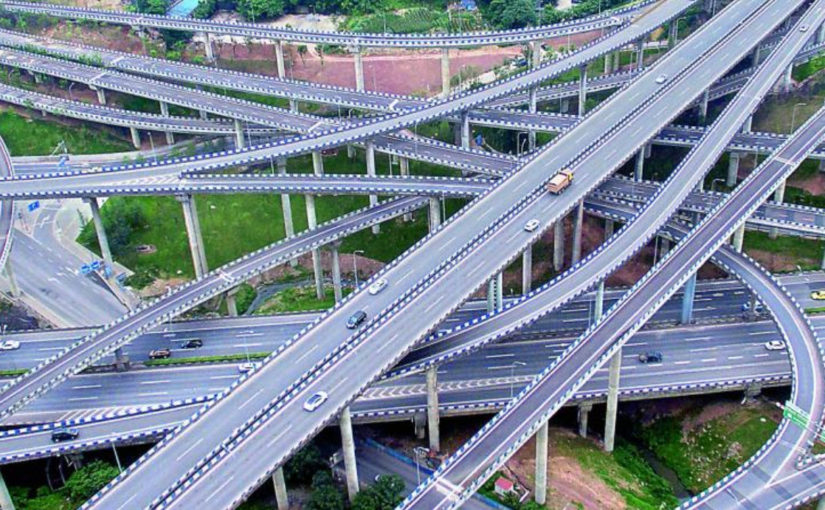If you read the American media, one thing that runs through all the propaganda, and it’s an on-going theme. It’s pretty much this; [1] China is hard-core communist, and thus [2] everything they do is a lie. [3] America must disengage from that lie. And, [4] when the time is right, America destroy China completely.
This is a pretty big departure from the “most favored trading status nation” to “America’s number one enemy”.
I call it the “Trump effect”. Which is pretty much a nation being run upon delusions and fantasy. You all can thank Trump and his “God fearing” neocon advisers who (foolishly) believe that America is Heaven on earth, and it is their God-Given right to rule the world, and remake it into an American vassal state.
For decades, China labored and provided goods to America. Once America could no longer afford those goods, the American leadership wanted to crush China completely and seize everything inside China for their own personal use.
This is really, seriously, all messed up.
This isn’t 1840, don’t you know.
But China is not what the American leadership thinks it is. China is a serious, serious nation. It is run by leadership who where tops in their classes, experienced hardship by working their way from the very bottom of society to where they are now, and who have displayed merit over and over again. It’s a big change from the “clowns” and “misfits” that currently run America.
In this post we will look at what China has been doing over the last few decades while America has gotten, fat, lazy, slothful and rich. We will look at the efforts that they made to become a world-leader in manufacturing. And then, we will look at where this effort has got them, and what China has become as a result of it; indeed, what China is today.
To start off, however, we need to look at how China started out, and what they did to become where they are today.
Hint: It took [1] real leadership, and [2] structural changes within the government.
We start with a post titled “Just Cheap Labor? How China Became a Manufacturing Powerhouse” by The World Affairs Blog. Posted on 13SEP20. Reprinted as found with only minor alternations to fit this venue. All credit to the writers and editors.
Just Cheap Labor? How China Became a Manufacturing Powerhouse
Many people have simple narratives about China’s rise as a manufacturing powerhouse. And this misunderstanding (ignorance?) is also the reason why the same people believe that multinational corporations are going to quickly move or re-shore factories out of China. The logic behind this narrative mostly boils down to, “China has cheap labor and thus became a manufacturing giant.”
It’s just not true.
For starters, if poverty is the sole requirement to become a manufacturing center, obviously every other developing country would have performed well. Consider this: while China and India have almost the same population, China’s manufacturing is almost 10x India’s. Thus, let’s analyze this phenomenon more closely.
China’s growth in manufacturing over the last forty years has been nothing but astonishing. Consider that, in 1980, US manufacturing output was almost five times as large as China’s. However, just thirty years later — in 2010 — China surpassed the US as the world’s #1 manufacturing country. This was also quite momentous, since the US had been the manufacturing leader for the previous 110 years!
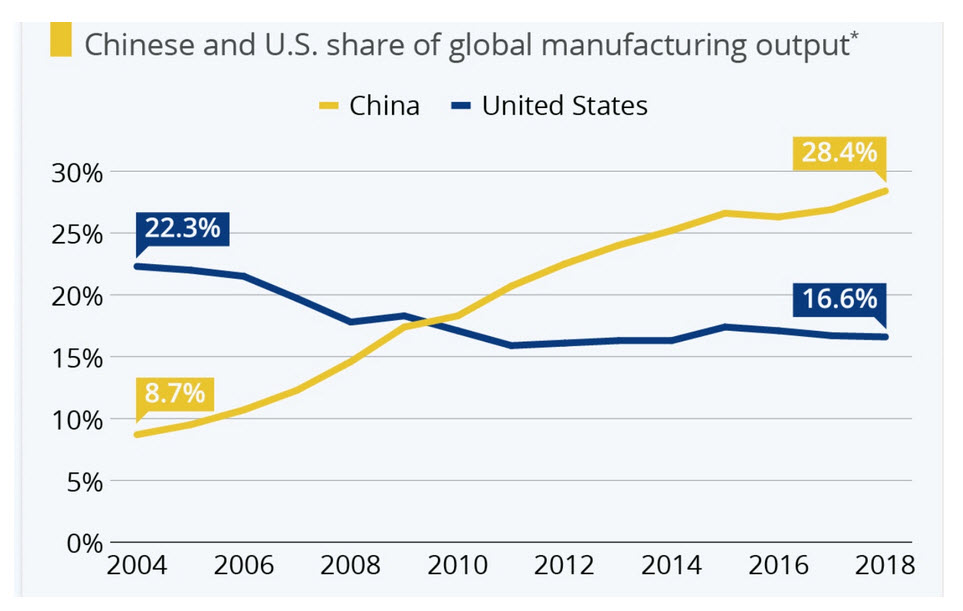
One more astonishing data: in the last one year, China’s trade surplus in manufactured goods was … whopping $1 trillion.
Of course, cheap labor made a big difference in the 1980s, 1990s and even until 2006 or so. However, after that, China’s wages caught up with other middle-income developing countries. Now, Chinese wages are 2.5x higher than in Mexico or 5x higher than in Vietnam.

Thus, while the Chinese wages tripled over a decade (2008-2018), China’s share of global manufacturing value added almost doubled from 15% to 28%!
So, obviously, there’s lot more than cheap labor.
In fact there are dozens of holistic factors that make a country a successful manufacturer. (Not all of them are positive — for example, lax environmental laws — but that’s the dark side of manufacturing). Understanding these will help see what a daunting challenge foreign companies will face in finding new countries to replace China.
There’s no one magic bullet, and all the ten factors listed below are critical:
**1. Skilled, Productive and Disciplined Labor: Yes, more than being cheap, even the lowest paid workers must have all these three qualities. The people making shoes or assembling gadgets still need skills and consistency. Products and requirements change all the time, and the workers should be able to adapt. Moreover, these people must show up for work every day and consistently perform. In many countries, you can’t find such high-quality workers.

**2. Medium and Hi-tech Manufacturing Factories: A plastic toy or a bulb may seem very simple, but there’s a lot of chemistry, metallurgy, materials science and much more behind how to make them from raw materials. Now imagine TVs, car engines etc. Factories need very sophisticated engineers to make the products to specifications at the right cost. There’s a lot of innovation here behind the scene. Here’s a quick note from Tim Cook (Apple’s CEO) on this topic:
https://video.wordpress.com/embed/re5h9oLH?preloadContent=metadata&hd=1
**3. Producing at Scale: Assembling 100,000 iPhones a day requires a totally different factory from the one that churns out 1,000 smartphones a day — every process will be different from end to end. Automation, smart factories, robots, and 5G will be increasingly crucial in the factories of the future.
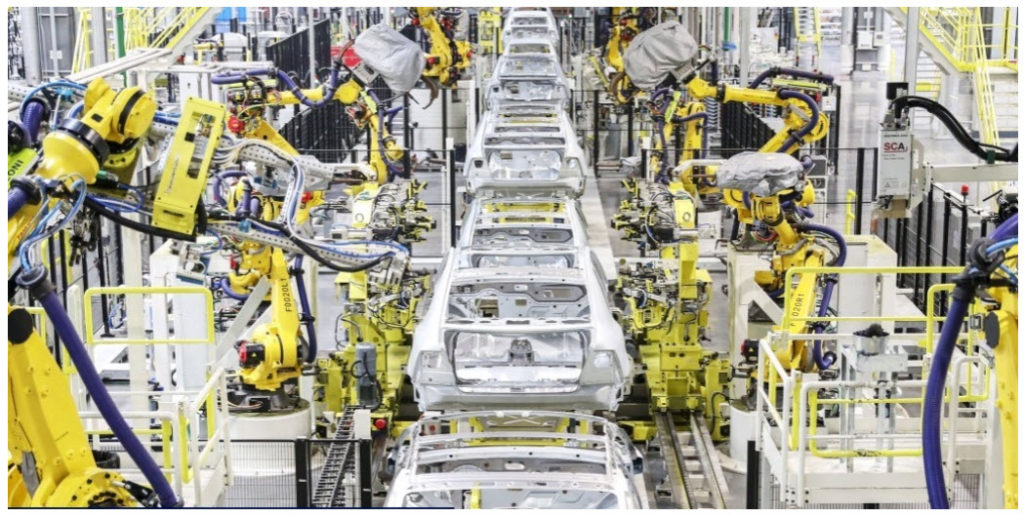
**4. Elasticity and Flexibility: Can you handle a sudden extra request for 1 million new gadgets to meet demands for Christmas? Can you quickly switch from one version to another version of a product? For example, China was able to quickly build huge mask factories and COVID19 testing labs within 2-3 weeks.
Is that possible in Vietnam? In Britain? In Canada? In the United States?
**5. Design to Prototypes to Products: Customers just come up with vague or highly complex product designs and then expect the manufacturer to do all the work. Chinese firms have so much talent and experience that they can often create a prototype within a couple of days. And these firms must be creative enough to suggest alternative designs and features. These are invaluable skills that just can’t be developed in a few months.
**6. Logistics: How do you make sure that the parts and raw materials are always available for the factories? How do you manage all the workers? How about testing and shipping out all the products on time? How do you work with customers from all over the world and deal with different languages, legal issues etc.?
**7. Infrastructure: The Chinese government has to make sure that the factories have land, electricity, water, buildings, warehouses, roads, Internet etc. And they must be affordable. These may sound easy to someone in the US, but developing nations like India or Indonesia may struggle to provide high-quality infrastructure. For example, until recently, massive power outages used to be very common in India.
**8. Transportation: Although this falls under infrastructure, it must be spelled out. A bullet train that reduces travel time by 60% … deep sea ports that can handle massive ships and millions of containers … new strategically located airports all over the country … freight trains that can travel thousands of miles (like from Xian, China to Barcelona, Spain) … these are monumental projects in which no country can match China. This is why Xi Jinping’s Belt and Road Initiative is truly visionary.

**9. Ecosystem: This is a unique success factor for China. There is an ecosystem for every kind of factory. For example, a clothing factory would greatly benefit if there are dozens of nearby factories that specialize in different kinds of materials — cotton, wool, silk, denim, nylon, polyester etc. Similarly, a smartphone company would like to work closely with other firms that specialize in microphones, speakers, cameras, screens, printed circuit boards etc. Other services experts such as international lawyers, marketing consultants, and designers are also indispensable. Without such 360-degree ecosystems, no country can expect to be a manufacturing superpower. Shenzhen, the electronics capital of the world, is a stellar example of such ecosystems.
**10. Tax Breaks, Subsidies, Incentives, Trade Agreements: Finally, you need a very smart and visionary government that plans 5, 10, 20 years in advance, makes huge investments, knows how to attract and keep foreign and domestic investors, provide tax cuts and subsidies, negotiate smart trade agreements etc. to create a win-win environment.
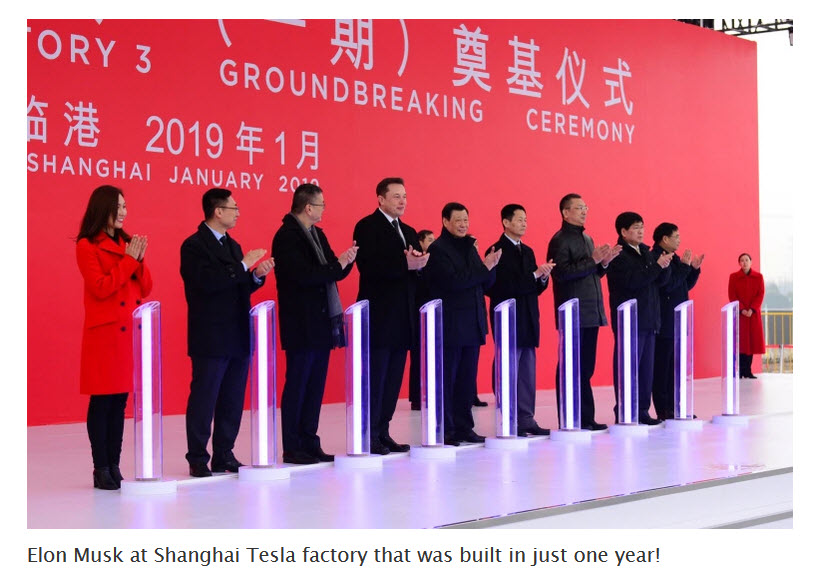
So, these are the secrets behind China’s success. Other countries can try to replicate this model, but they need to be prepared to invest a lot and plan for the long term.
While low-end manufacturing will move out of China because of high Chinese wages and China’s desire to improve its environment, Americans shouldn’t dream of quick decoupling or re-shoring factories. This is why 75% of US manufacturers in China say they won’t move any production out of China! Moving out of China in any meaningful way will take a decade … if other developing nations execute their manufacturing strategy flawlessly.
And now that you know about how China got to where it is, you can see how this all affects it’s global standing…
The following is also from the World Affairs Blog and it is titled “China’s GDP is now $14.4 trillion. Within ten years …“, it was edited to fit this venue and all credit tothe author.
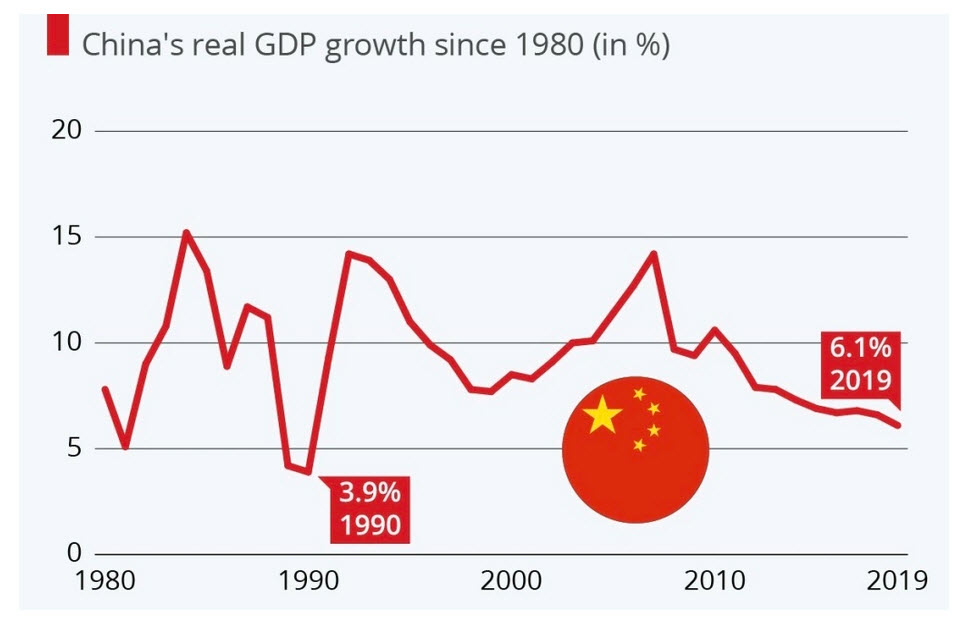
China’s GDP is now $14.4 trillion. Within ten years …
China slowed down a bit, thanks to trade war and tariffs, but didn’t suffer a lot.
The mainstream media gave it a spin as “China’s economy grows at the slowest pace in 29 years!” However, the slowdown in China’s growth is natural at this stage of its development. Nothing can grow at 15% forever.
What is not mentioned by the China-haters is that China grew much faster than the US economy and left other major economies like EU and Japan in the dust.
Here are the numbers for GDP growth in 2019 — China: 6.1%, USA: 2.2%, EU: 1.4% and Japan: 0.7%.
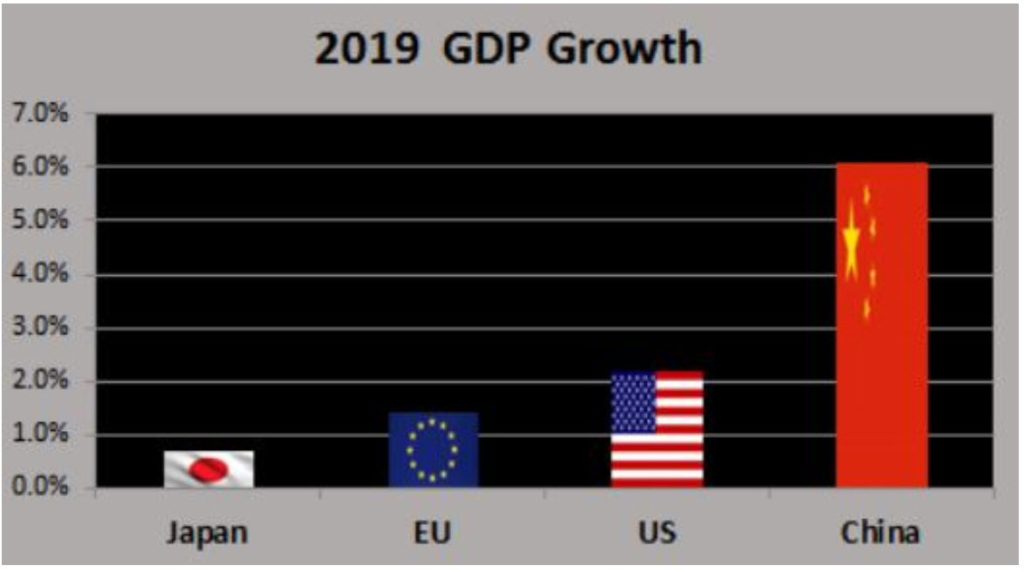
Note that, the official GDP growth are always inflation-adjusted. This is a strange norm that distorts reality. We don’t do this to other stats like stock market or wages. Thus, in real life, China’s GDP actually grew 10% … from Ұ90 trillion to Ұ99 trillion.
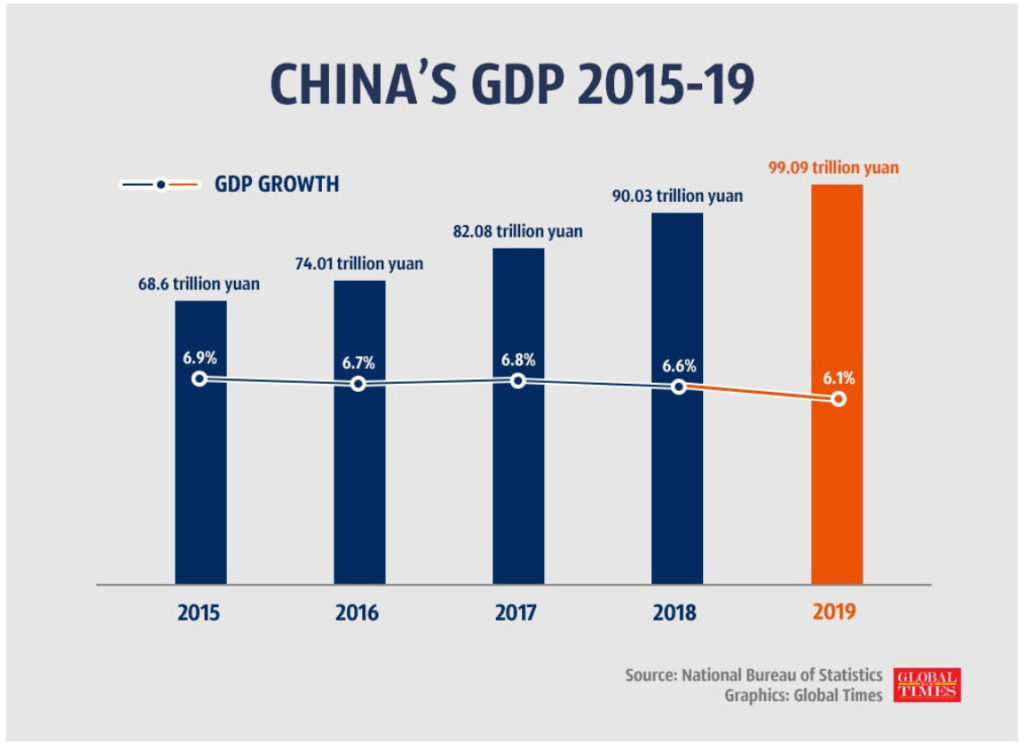
Thus, last year, China’s GDP grew by Ұ9 trillion… which translates to $1.4 trillion. For comparison, the US economy grew by $1 trillion. See the difference? This is how China catches up to the US.
Every year from now on, China will reduce the gap with the US by $400 billion or more.
World Beyond the US
How did China achieve this growth? How come the trade war and tariffs didn’t wreck the Chinese economy?
There are two answers:
One, the significance of American economy is shrinking.
In 2019, the US became the third trading partner for China! Not number one. Not number two. Third.
The top two were EU and ASEAN (a group of 10 countries in Asia). The Belt and Road countries also increased their trade with China.
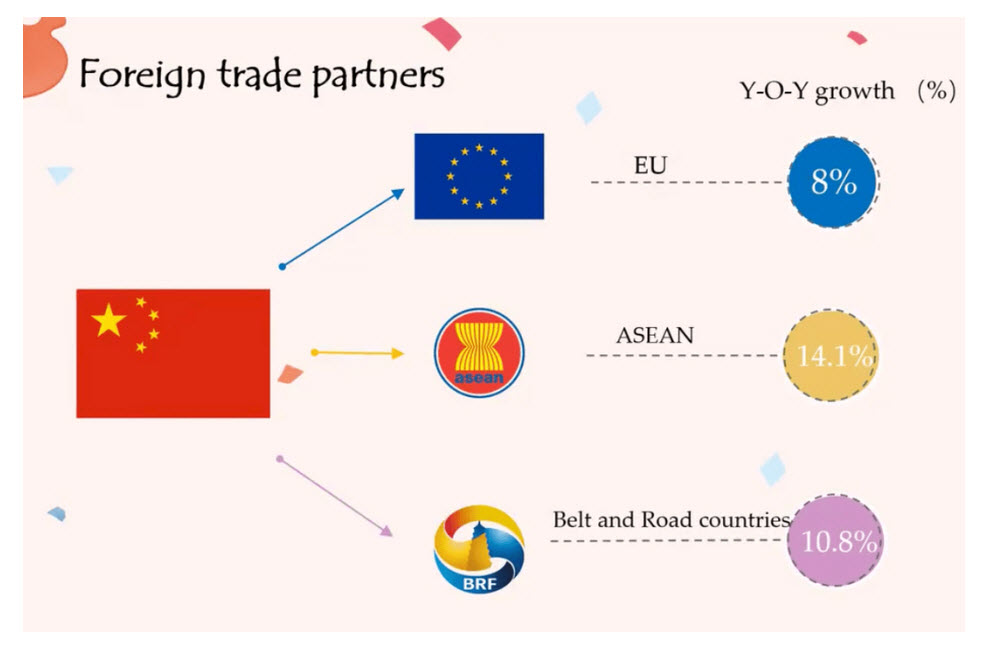
Two, China’s economy is no longer dominated by manufacturing.
Services sector — “tertiary industry” — is now 54% of the economy; and manufacturing is only 40%. Since services depend mostly on domestic consumption, trade war doesn’t have much impact.
Thus the “Trade War” does not affect domestic consumption. Only international trade with China’s third largest trading partner; America.
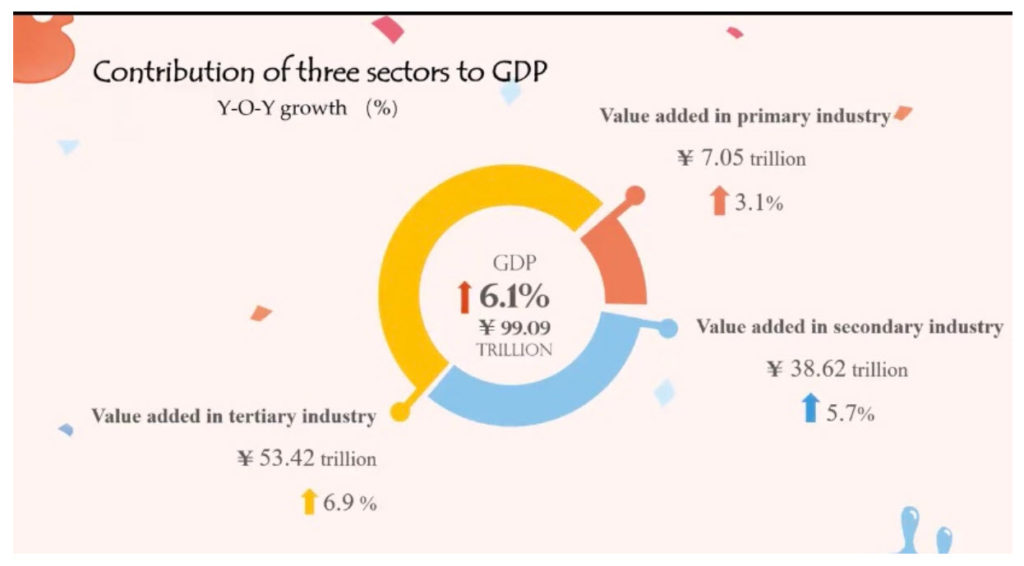
Future
If you look at the relative size of China to the US over the last 30 years, you can see how China is catching up:
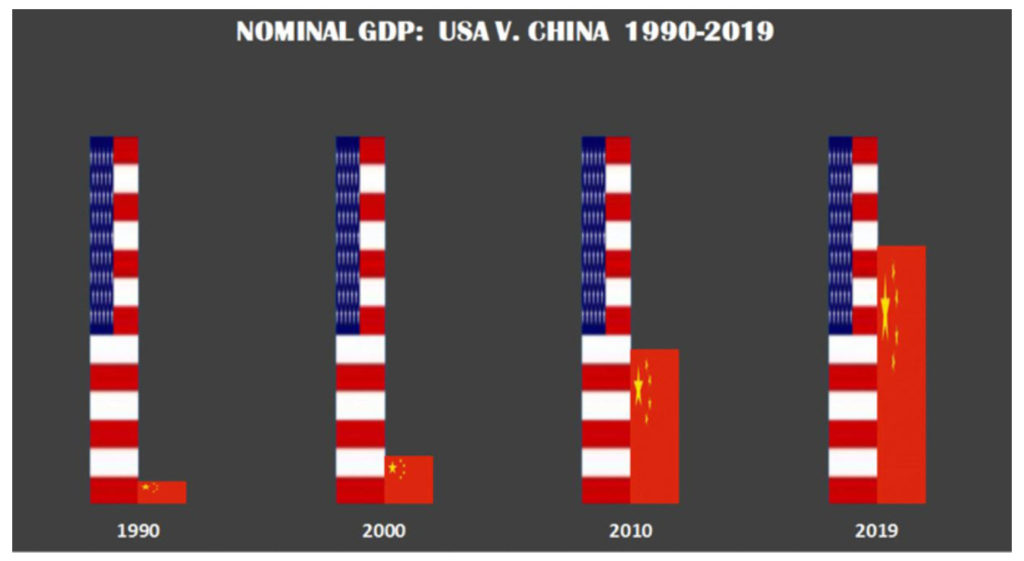
With 4x as many people — who also work very hard — and a government that surprisingly plans and coordinates the economy very well, it should be no surprise that China will surpass the US by 2030 in nominal GDP. (Don’t forget that China has been #1 in terms of PPP GDP since 2014).
Of course, the trajectory is based on the assumption there won’t be any major financial crisis or hot wars in the coming decade, which are all quite possible…
Conclusion
It should not be any mystery to anyone not drinking the “electric kool-aide” from the American (and Western) media. China is successful precisely because of it’s leadership, planning and hard work.
- It is not a “democracy” where public opinion can change the leadership on a whim. It is a Socialist Republic run by merit. It doesn’t need to lie. They just tell you what things are, and you can accept it or not.
- All Chinese leadership worked to get where they are today. They lead China into what it has become.
- The Chinese people, culture and the Chinese society, along with proper investment and long term planning has created a situation where China is the global leader that America considers so much a threat.
- China will continue this path that it is on, and the only thing that can slow it down (but not stop it) would be a “hot war” with America.
- To this end, China is working with other nations. Creating and building long-lasting friendships and relationships. While America is tearing down relationships, ignoring treaties, and generally being a global nuisance.
Do you want more?
I have more posts like this in my China Index here…
ChinaArticles & Links
You’ll not find any big banners or popups here talking about cookies and privacy notices. There are no ads on this site (aside from the hosting ads – a necessary evil). Functionally and fundamentally, I just don’t make money off of this blog. It is NOT monetized. Finally, I don’t track you because I just don’t care to.
To go to the MAIN Index;
Master Index.
- You can start reading the articles by going HERE.
- You can visit the Index Page HERE to explore by article subject.
- You can also ask the author some questions. You can go HERE .
- You can find out more about the author HERE.
- If you have concerns or complaints, you can go HERE.
- If you want to make a donation, you can go HERE.
Please kindly help me out in this effort. There is a lot of effort that goes into this disclosure. I could use all the financial support that anyone could provide. Thank you very much.
[wp_paypal_payment]

